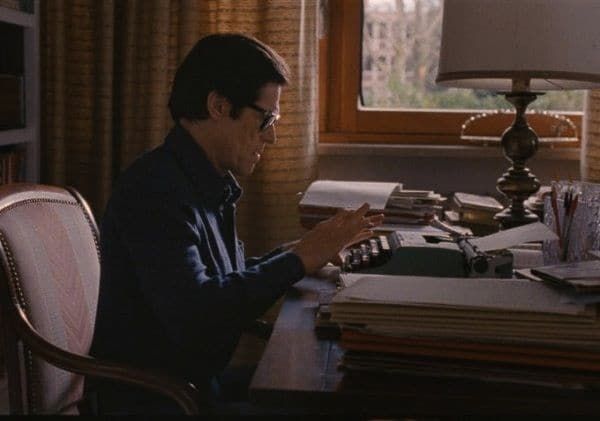Eye For Film >> Movies >> Pasolini (2014) Film Review
Pasolini
Reviewed by: Anne-Katrin Titze

Abel Ferrara's tableau of Pier Paolo Pasolini resembles a large villa. Each room we enter establishes a different angle on the filmmaker, writer, painter, thinker and prowler. He doesn't simplify anything about his subject and he has a fantastic ally in Willem Dafoe.
The mistake of wrapping up a life neatly in hindsight, which is made so often by biopics, doesn't interest Ferrara. Pasolini's unfinished life remains painfully unresolved, as it should be. In a daring move, scenes from the film Pasolini was working on at the time of his murder are staged.

Epifanio, to be played by his lover and friend Ninetto Davoli (Riccardo Scamarcio) sees a shooting star and follows it, by what looks like a train ride to the town of Sodom where he and his travel companion witness the yearly festival of reproduction, the one day when the inhabitants counter their sexual preferences in order to not become extinct.
Clips from Salo, Or The 120 Days Of Sodom, inspired by the Marquis de Sade and released shortly after Pasolini's death, are included here and remain just as provocative in 2014. They are a good preparation for what is to come.
It can be a bit confusing to locate the exact narrative floor we are on at any given moment, yet that is also the beauty of Pasolini - the man and the movie.
“Mine is not a tale. It is a parable. The meaning of this parable is the relation of an author to the form he creates.” One of the many poignant Pasolini quotes, it was chosen, as Ferrara told me when I spoke with him and Dafoe at the New York Film Festival, by the unholy trinity of the two of them and screenwriter Maurizio Braucci.
Pasolini had a special love for the format of frame narratives and made films inspired by some of the greatest in history. The Decameron by Giovanni Boccaccio, The Canterbury Tales by Geoffrey Chaucer and A Thousand And One Nights, the collection of Arabic stories with fragments going back to the 9th century. In Teorema, Pasolini invented his own cumulative tale of the mysterious visitor who seduces every member of the household.
"The protagonist, despite similarities is repugnant to me." We see Dafoe meticulously dressed in many cases in Pasolini's own clothes, sitting in a plane, smoking like a smokestack, flying over the Sudan, musing over "the pink color of the desert," dreaming up a crash in the space of his imagination. It is "the death wish that binds us together," he says as he confronts his own - to a point.
The very structure and control is shown as a necessity for Pasolini in order to tackle transgression as he did. Lunch, at the apartment he shared with his mother (Adriana Asti), concludes in a dance. Actress Laura Betti (Maria de Medeiros), who "dubbed the devil's voice," brought him a record of traditional Croatian folk music. She and Pasolini's assistant Graziella (Giada Colagrande) dance while holding a napkin between them, while Pasolini looks on and smiles.
Dafoe's face expresses warmth and shyness, annoyance and jealousy all at once. We are all in danger, he says with his eyes. Let's explore the freedom we have while we can.
"There is nothing that isn't political," says Pasolini in Ferrara's reconstruction of a final interview, during which the Italian filmmaker is asked why he is no longer militant. The conjuring of a spellbinding narrative of Pasolini's last day on earth takes the audience from childhood memories, via graphic film clips, to a comet following, unfinished future. Dafoe is caught up in a storm. And a rainbow. Pasolini is shown in all his inconsistencies. Intelligence and style have never been in contradiction to descent into personal hell for Ferrara either.
Reviewed on: 08 Oct 2014















